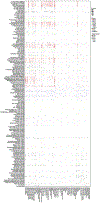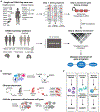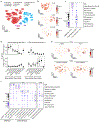Identifying disease-critical cell types and cellular processes by integrating single-cell RNA-sequencing and human genetics
- PMID: 36175791
- PMCID: PMC9910198
- DOI: 10.1038/s41588-022-01187-9
Identifying disease-critical cell types and cellular processes by integrating single-cell RNA-sequencing and human genetics
Abstract
Genome-wide association studies provide a powerful means of identifying loci and genes contributing to disease, but in many cases, the related cell types/states through which genes confer disease risk remain unknown. Deciphering such relationships is important for identifying pathogenic processes and developing therapeutics. In the present study, we introduce sc-linker, a framework for integrating single-cell RNA-sequencing, epigenomic SNP-to-gene maps and genome-wide association study summary statistics to infer the underlying cell types and processes by which genetic variants influence disease. The inferred disease enrichments recapitulated known biology and highlighted notable cell-disease relationships, including γ-aminobutyric acid-ergic neurons in major depressive disorder, a disease-dependent M-cell program in ulcerative colitis and a disease-specific complement cascade process in multiple sclerosis. In autoimmune disease, both healthy and disease-dependent immune cell-type programs were associated, whereas only disease-dependent epithelial cell programs were prominent, suggesting a role in disease response rather than initiation. Our framework provides a powerful approach for identifying the cell types and cellular processes by which genetic variants influence disease.
© 2022. The Author(s), under exclusive licence to Springer Nature America, Inc.
Conflict of interest statement
COMPETING INTERESTS
A.R. is a co-founder and equity holder of Celsius Therapeutics, an equity holder in Immunitas, and was an SAB member of ThermoFisher Scientific, Syros Pharmaceuticals, Neogene Therapeutics and Asimov. From August 1, 2020, A.R. is an employee of Genentech. The remaining authors declare no competing interests.
Figures

















Update of
-
Identifying disease-critical cell types and cellular processes across the human body by integration of single-cell profiles and human genetics.bioRxiv [Preprint]. 2021 Nov 23:2021.03.19.436212. doi: 10.1101/2021.03.19.436212. bioRxiv. 2021. Update in: Nat Genet. 2022 Oct;54(10):1479-1492. doi: 10.1038/s41588-022-01187-9. PMID: 34845454 Free PMC article. Updated. Preprint.
Comment in
-
Linking disease-associated genetic variants to cell types and processes.Nat Rev Genet. 2022 Dec;23(12):712-713. doi: 10.1038/s41576-022-00545-x. Nat Rev Genet. 2022. PMID: 36229692 No abstract available.
References
Publication types
MeSH terms
Substances
Grants and funding
- R37 MH107649/MH/NIMH NIH HHS/United States
- P30 DK043351/DK/NIDDK NIH HHS/United States
- R01 MH115676/MH/NIMH NIH HHS/United States
- R35 HG011324/HG/NHGRI NIH HHS/United States
- U01 HG009379/HG/NHGRI NIH HHS/United States
- R01 MH101244/MH/NIMH NIH HHS/United States
- R01 MH109978/MH/NIMH NIH HHS/United States
- HHMI/Howard Hughes Medical Institute/United States
- R01 HG006399/HG/NHGRI NIH HHS/United States
- K99 HG012203/HG/NHGRI NIH HHS/United States
- U24 AI118672/AI/NIAID NIH HHS/United States
- R00 HG009917/HG/NHGRI NIH HHS/United States
LinkOut - more resources
Full Text Sources

